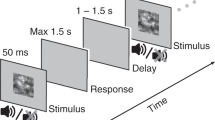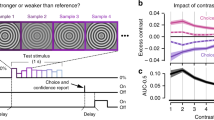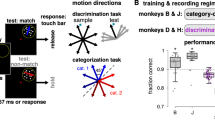Abstract
An emerging view in perceptual learning is that improvements in perceptual sensitivity are not only due to enhancements in early sensory representations but also due to changes in post-sensory decision-processing. In humans, however, direct neurobiological evidence of the latter remains scarce. Here, we trained participants on a visual categorization task over three days and used multivariate pattern analysis of the electroencephalogram to identify two temporally specific components encoding sensory (‘Early’) and decision (‘Late’) evidence, respectively. Importantly, the single-trial amplitudes of the Late, but not the Early component, were amplified in the course of training, and these enhancements predicted the behavioural improvements on the task. Correspondingly, we modelled these improvements with a reinforcement learning mechanism, using a reward prediction error signal to strengthen the readout of sensory evidence used for the decision. We validated this mechanism through a robust association between the model’s decision variables and the amplitudes of our Late component that encode decision evidence.
This is a preview of subscription content, access via your institution
Access options
Access Nature and 54 other Nature Portfolio journals
Get Nature+, our best-value online-access subscription
$29.99 / 30 days
cancel any time
Subscribe to this journal
Receive 12 digital issues and online access to articles
$119.00 per year
only $9.92 per issue
Buy this article
- Purchase on Springer Link
- Instant access to full article PDF
Prices may be subject to local taxes which are calculated during checkout





Similar content being viewed by others
References
Gilbert, C. D., Sigman, M. & Crist, R. E. The neural basis of perceptual learning. Neuron 31, 681–697 (2001).
Goldstone, R. L. Perceptual learning. Annu. Rev. Psychol. 49, 585–612 (1998).
Ball, K. & Sekuler, R. Direction-specific improvement in motion discrimination. Vision Res. 27, 953–965 (1987).
Crist, R. E., Kapadia, M. K., Westheimer, G. & Gilbert, C. D. Perceptual learning of spatial localization: specificity for orientation, position, and context. J. Neurophysiol. 78, 2889–2894 (1997).
Fahle, M. & Edelman, S. Long-term learning in vernier acuity: effects of stimulus orientation, range and of feedback. Vis. Res. 33, 397–412 (1993).
Fiorentini, A. & Berardi, N. Perceptual learning specific for orientation and spatial frequency. Nature 287, 43–44 (1980).
Karni, A. & Sagi, D. Where practice makes perfect in texture discrimination: evidence for primary visual cortex plasticity. Proc. Natl Acad. Sci. USA 88, 4966–4970 (1991).
Poggio, T., Fahle, M. & Edelman, S. Fast perceptual learning in visual hyperacuity. Science 256, 1018–1021 (1992).
Sagi, D. & Tanne, D. Perceptual learning: learning to see. Curr. Opin. Neurobiol. 4, 195–199 (1994).
Ahissar, M. & Hochstein, S. Task difficulty and the specificity of perceptual learning. Nature 387, 401–406 (1997).
Mollon, J. D. & Danilova, M. V. Three remarks on perceptual learning. Spat. Vis. 10, 51–58 (1996).
Ahissar, M. & Hochstein, S. Attentional control of early perceptual learning. Proc. Natl Acad. Sci. USA 90, 5718–5722 (1993).
Law, C.-T. & Gold, J. I. Neural correlates of perceptual learning in a sensory-motor, but not a sensory, cortical area. Nat. Neurosci. 11, 505–513 (2008).
Law, C.-T. & Gold, J. I. Reinforcement learning can account for associative and perceptual learning on a visual-decision task. Nat. Neurosci. 12, 655–663 (2009).
Baldassarre, A. et al. Individual variability in functional connectivity predicts performance of a perceptual task. Proc. Natl Acad. Sci. USA 109, 3516–3521 (2012).
Chen, N. H. et al. Sharpened cortical tuning and enhanced cortico-cortical communication contribute to the long-term neural mechanisms of visual motion perceptual learning. NeuroImage 115, 17–29 (2015).
Kahnt, T., Grueschow, M., Speck, O. & Haynes, J.-D. Perceptual learning and decision-making in human medial frontal cortex. Neuron 70, 549–559 (2011).
Lewis, C. M., Baldassarre, A., Committeri, G., Romani, G. L. & Corbetta, M. Learning sculpts the spontaneous activity of the resting human brain. Proc. Natl Acad. Sci. USA 106, 17558–17563 (2009).
Philiastides, M. G., Ratcliff, R. & Sajda, P. Neural representation of task difficulty and decision making during perceptual categorization: a timing diagram. J. Neurosci. 26, 8965–8975 (2006).
Philiastides, M. G. & Sajda, P. Temporal characterization of the neural correlates of perceptual decision making in the human brain. Cereb. Cortex 16, 509–518 (2006).
Philiastides, M. G. & Sajda, P. Causal influences in the human brain during face discrimination: a short-window directed transfer function approach. IEEE Trans. Biomed. Eng. 53, 2602–2605 (2006).
Philiastides, M. G. & Sajda, P. EEG-informed fMRI reveals spatiotemporal characteristics of perceptual decision making. J. Neurosci. 27, 13082–13091 (2007).
Ratcliff, R., Philiastides, M. G. & Sajda, P. Quality of evidence for perceptual decision making is indexed by trial-to-trial variability of the EEG. Proc. Natl Acad. Sci. USA 106, 6539–6544 (2009).
Rushworth, M. F., Mars, R. B. & Summerfield, C. General mechanisms for making decisions? Curr. Opin. Neurobiol. 19, 75–83 (2009).
Schultz, W., Dayan, P. & Montague, P. R. A neural substrate of prediction and reward. Science 275, 1593–1599 (1997).
Guggenmos, M., Wilbertz, G., Hebart, M. N. & Sterzer, P. Mesolimbic confidence signals guide perceptual learning in the absence of external feedback. eLife 5, e13388 (2016).
Parra, L. C., Spence, C. D., Gerson, A. D. & Sajda, P. Recipes for the linear analysis of EEG. NeuroImage 28, 326–341 (2005).
Sajda, P., Philiastides, M. G. & Parra, L. C. Single-trial analysis of neuroimaging data: inferring neural networks underlying perceptual decision-making in the human brain. IEEE Rev. Biomed. Eng. 2, 97–109 (2009).
Ratcliff, R. & Smith, P. L. Perceptual discrimination in static and dynamic noise: the temporal relation between perceptual encoding and decision making. J. Exp. Psychol. Gen. 139, 70–94 (2010).
Ratcliff, R., Smith, P. L. & McKoon, G. Modeling regularities in response time and accuracy data with the diffusion model. Curr. Dir. Psychol. Sci. 24, 458–470 (2015).
Smith, P. L. & Ratcliff, R. Psychology and neurobiology of simple decisions. Trends Neurosci. 27, 161–168 (2004).
Petrov, A. A., Dosher, B. A. & Lu, Z.-L. The dynamics of perceptual learning: an incremental reweighting model. Psychol. Rev. 112, 715 (2005).
Fouragnan, E., Retzler, C., Mullinger, K. & Philiastides, M. G. Two spatiotemporally distinct value systems shape reward-based learning in the human brain. Nat. Commun. 6, 8107 (2015).
Philiastides, M. G., Biele, G., Vavatzanidis, N., Kazzer, P. & Heekeren, H. R. Temporal dynamics of prediction error processing during reward-based decision making. NeuroImage 53, 221–232 (2010).
Lou, B., Li, Y., Philiastides, M. G. & Sajda, P. Prestimulus alpha power predicts fidelity of sensory encoding in perceptual decision making. NeuroImage 87, 242–251 (2014).
Kelly, S. P. & O'Connell, R. G. Internal and external influences on the rate of sensory evidence accumulation in the human brain. J. Neurosci. 33, 19434–19441 (2013).
O'Connell, R. G., Dockree, P. M. & Kelly, S. P. A supramodal accumulation-to-bound signal that determines perceptual decisions in humans. Nat. Neurosci. 15, 1729–1735 (2012).
Philiastides, M. G., Heekeren, H. R. & Sajda, P. Human scalp potentials reflect a mixture of decision-related signals during perceptual choices. J. Neurosci. 34, 16877–16889 (2014).
Sutton, R. S. & Barto, A. G. Reinforcement Learning: An Introduction (MIT Press, 1998).
O'Doherty, J. P., Dayan, P., Friston, K., Critchley, H. & Dolan, R. J. Temporal difference models and reward-related learning in the human brain. Neuron 38, 329–337 (2003).
Pessiglione, M., Seymour, B., Flandin, G., Dolan, R. J. & Frith, C. D. Dopamine-dependent prediction errors underpin reward-seeking behaviour in humans. Nature 442, 1042–1045 (2006).
Fahle, M. Perceptual learning: a case for early selection. J. Vis. 4, 879–890 (2004).
Fahle, M. Perceptual learning: specificity versus generalization. Curr. Opin. Neurobiol. 15, 154–160 (2005).
Schwartz, S., Maquet, P. & Frith, C. Neural correlates of perceptual learning: a functional MRI study of visual texture discrimination. Proc. Natl Acad. Sci. USA 99, 17137–17142 (2002).
Furmanski, C. S., Schluppeck, D. & Engel, S. A. Learning strengthens the response of primary visual cortex to simple patterns. Curr. Biol. 14, 573–578 (2004).
Jehee, J. F., Ling, S., Swisher, J. D., van Bergen, R. S. & Tong, F. Perceptual learning selectively refines orientation representations in early visual cortex. J. Neurosci. 32, 16747–16753 (2012).
Bao, M., Yang, L., Rios, C., He, B. & Engel, S. A. Perceptual learning increases the strength of the earliest signals in visual cortex. J. Neurosci. 30, 15080–15084 (2010).
Pourtois, G., Rauss, K. S., Vuilleumier, P. & Schwartz, S. Effects of perceptual learning on primary visual cortex activity in humans. Vis. Res. 48, 55–62 (2008).
Censor, N., Bonneh, Y., Arieli, A. & Sagi, D. Early-vision brain responses which predict human visual segmentation and learning. J. Vis. 9, 12. 1–9 (2009).
Ghose, G. M., Yang, T. & Maunsell, J. H. Physiological correlates of perceptual learning in monkey V1 and V2. J. Neurophysiol. 87, 1867–1888 (2002).
Schoups, A., Vogels, R., Qian, N. & Orban, G. Practising orientation identification improves orientation coding in V1 neurons. Nature 412, 549–553 (2001).
Yan, Y. et al. Perceptual training continuously refines neuronal population codes in primary visual cortex. Nat. Neurosci. 17, 1380–1387 (2014).
Dosher, B. A. & Lu, Z. L. Mechanisms of perceptual learning. Vis. Res. 39, 3197–3221 (1999).
Lu, Z.-L., Liu, J. & Dosher, B. A. Modeling mechanisms of perceptual learning with augmented Hebbian re-weighting. Vis. Res. 50, 375–390 (2010).
Kuai, S.-G., Levi, D. & Kourtzi, Z. Learning optimizes decision templates in the human visual cortex. Curr. Biol. 23, 1799–1804 (2013).
Li, S., Mayhew, S. D. & Kourtzi, Z. Learning shapes the representation of behavioral choice in the human brain. Neuron 62, 441–452 (2009).
Shibata, K., Watanabe, T., Sasaki, Y. & Kawato, M. Perceptual learning incepted by decoded fMRI neurofeedback without stimulus presentation. Science 334, 1413–1415 (2011).
Shibata, K., Sagi, D. & Watanabe, T. Two-stage model in perceptual learning: toward a unified theory. Ann. NY Acad. Sci. 1316, 18–28 (2014).
Watanabe, T. & Sasaki, Y. Perceptual learning: toward a comprehensive theory. Annu. Rev. Psychol. 66, 197–221 (2015).
Li, W., Piech, V. & Gilbert, C. D. Perceptual learning and top-down influences in primary visual cortex. Nat. Neurosci. 7, 651–657 (2004).
Perna, A., Tosetti, M., Montanaro, D. & Morrone, M. C. BOLD response to spatial phase congruency in human brain. J. Vis. 8, 15. 1–15 (2008).
Troje, N. F. & Bìlthoff, H. H. Face recognition under varying poses: the role of texture and shape. Vis. Res. 36, 1761–1771 (1996).
Dakin, S. C., Hess, R. F., Ledgeway, T. & Achtman, R. L. What causes non-monotonic tuning of fMRI response to noisy images? Curr. Biol. 12, R476–R477; author reply R478 (2002).
Peirce, J. W. PsychoPy — psychophysics software in Python. J. Neurosci. Methods 162, 8–13 (2007).
Gherman, S. & Philiastides, M. G. Neural representations of confidence emerge from the process of decision formation during perceptual choices. NeuroImage 106, 134–143 (2015).
Duda, R. O. & Hart, P. E. Pattern Classification and Scene Analysis Vol. 3 (Wiley, 1973).
Baayen, R. H., Davidson, D. J. & Bates, D. M. Mixed-effects modeling with crossed random effects for subjects and items. J. Mem. Lang. 59, 390–412 (2008).
Gelman, A. & Hill, J. Data Analysis Using Regression and Multilevel/Hierarchical Models (Cambridge Univ. Press, 2006).
Stephan, K. E. et al. Ten simple rules for dynamic causal modeling. NeuroImage 49, 3099–3109 (2010).
Stephan, K. E., Weiskopf, N., Drysdale, P. M., Robinson, P. A. & Friston, K. J. Comparing hemodynamic models with DCM. NeuroImage 38, 387–401 (2007).
Acknowledgements
This work was supported by the Economic and Social Research Council (ESRC; grant ES/L012995/1 to M.G.P.). The funders had no role in study design, data collection and analysis, decision to publish, or preparation of the manuscript.
Author information
Authors and Affiliations
Contributions
J.A.D. and M.G.P. designed the experiments. J.A.D. performed the experiments. J.A.D., F.Q. and M.G.P. analysed the data and wrote the paper.
Corresponding author
Ethics declarations
Competing interests
The authors declare no competing interests.
Rights and permissions
About this article
Cite this article
Diaz, J., Queirazza, F. & Philiastides, M. Perceptual learning alters post-sensory processing in human decision-making. Nat Hum Behav 1, 0035 (2017). https://doi.org/10.1038/s41562-016-0035
Received:
Accepted:
Published:
DOI: https://doi.org/10.1038/s41562-016-0035
This article is cited by
-
Intracranial electroencephalography reveals effector-independent evidence accumulation dynamics in multiple human brain regions
Nature Human Behaviour (2024)
-
A General Integrative Neurocognitive Modeling Framework to Jointly Describe EEG and Decision-making on Single Trials
Computational Brain & Behavior (2023)
-
40-Hz Binaural beats enhance training to mitigate the attentional blink
Scientific Reports (2020)
-
Auditory information enhances post-sensory visual evidence during rapid multisensory decision-making
Nature Communications (2020)
-
Neuroscience: When perceptual learning occurs
Nature Human Behaviour (2017)



